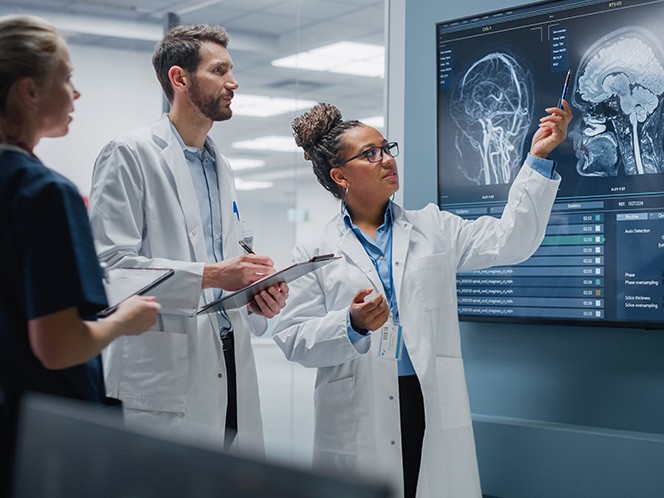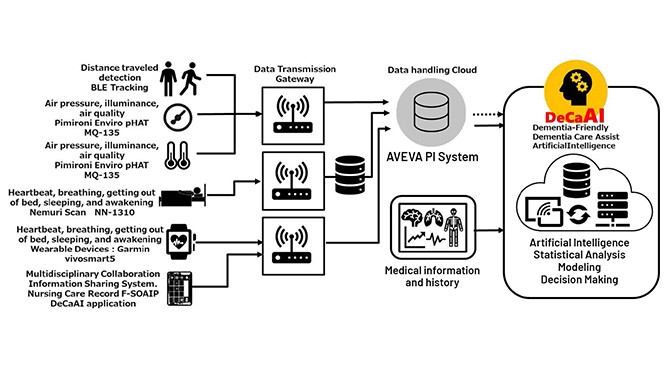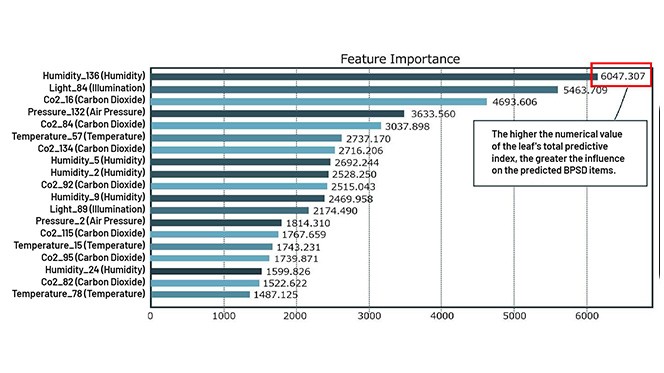More than 50 million people worldwide are living with dementia, experiencing symptoms including memory loss and disorientation. Patients often experience behavioral and psychological symptoms of dementia (BPSD), secondary symptoms that further complicate care. These symptoms can include anxiety, wandering, delusions and even aggressive behavior. The Senior Dementia Institute in Japan has taken an innovative approach to improving care for dementia patients, using data to predict and prevent dementia symptoms. Using AVEVA™ PI System™, the Senior Dementia Institute can track a variety of physical data points to predict behavioral symptoms before they occur.

Challenges
Dementia affects millions of people worldwide and is hard for caregivers to manage
Caregivers lacked real-time insights into patient symptoms
Researchers needed to collect and efficiently store large amounts of patient data
Results

insights from new sensors, datasets, and analyses makes caregivers more effective in real time

easily visualized data enables caregivers to understand patients better
83.2%
accuracy in predicting harmful behaviors one hour before they occur
Tracking data from physical sensors
Dementia patients experience high levels of forgetfulness, which causes BPSD symptoms that are hard for carers to manage. The Senior Dementia Institute wanted to understand the patterns and mechanisms causing these symptoms and selected a wide range of characteristics to monitor to gain further insight. These included physical, psychological, environmental and social factors.
The team needed an internet of things (IoT) system that could integrate data from a variety of sources and formats and could easily be scaled. They chose AVEVA PI System to manage their data, which included social data, such as observations from caregivers and education level, as well as environmental data, such as temperature, humidity and air quality. It also included measurements direct from the patient, such as blood pressure, heart rate and movement.
 The Senior Dementia Institute tracks a range of physical sensors that monitor things like heart and breathing rate
The Senior Dementia Institute tracks a range of physical sensors that monitor things like heart and breathing rate
With information from the nursing care team and caregiver observations, the researchers tagged the data that correlated with behavioral dementia symptoms. AVEVA PI System’s flexibility in changing application programming interfaces (APIs) and data formats made the data analysts’ job easier and enabled the team to iterate on their models faster.
“As the number of people living with dementia continues to rise, the burden on caregivers is also increasing. There is a growing need for more efficient, data-driven care solutions— and the AVEVA PI System plays a key role in making that possible.”
—Masaharu Hatano, Representative Director, Senior Dementia Institute
Visualizing the data
The researchers fed their tagged data into an AI model, which combined and integrated the large amounts of data and processed it based on existing knowledge about dementia. This allowed the team to create a system that tracked the onset of BPSD symptoms in dementia patients.
The Senior Dementia Institute team then began classifying their data, analyzing the link between a patient’s degree of independence and their behavioral dementia symptoms. They used trend analysis, which included mathematical models to predict future outcomes based on past results.
The AVEVA PI System provides the digital backbone for this work. It centrally manages data input from sensors and nurses and organizes it by history, search, and analysis corresponding to the model’s predictions. It forms a core part of the team’s Dementia Care Assistive Artificial Intelligence model (DeCaAI), which reliably collects and integrates large amounts of care information and visualizes the data so that caregivers can access and use it quickly via smartphones and tablets.
With properly visualized data through AVEVA™ PI Vision™, the researchers could classify the characteristic patterns of behavioral dementia symptoms to identify trends. For example, researchers observed that BPSD symptoms peaked in August and September. They hypothesized that this phenomenon could be linked to Japan’s unstable summer weather and the effects of low atmospheric pressure, which can disrupt sleep patterns and trigger abnormal behaviors.
Researchers also noted that a sudden increase in heart rate coincided with the onset of BPSD symptoms, which the AI model learned to recognize as a warning indicator for BPSD episodes.
“AVEVA PI System provides peace of mind by ensuring data security. It also efficiently compresses and stores data, helping to preserve the accuracy of large volumes of long-term biological data. This allows users to quickly reference data from years ago and utilize high-quality information for process analysis. The quality of the data greatly contributes to the reliability of analytical results, enabling more advanced analysis and the development of effective interventions.”
—Masaharu Hatano, Representative Director, Senior Dementia Institute
Solution
Senior Dementia Institute uses AVEVA™ PI System™ to collect, integrate and visualize large amounts of data in the cloud to inform dementia patients’ care and predict behavior.
 Tracking a variety of data points enabled the researchers to see which factors influenced patient behavior
Tracking a variety of data points enabled the researchers to see which factors influenced patient behavior
Predicting patient behavior with data
The AVEVA PI System classifies and contextualizes different types of patient data and stores them on its system. Researchers use AI models to predict patterns and behaviors based on events that happened in the previous days and months. With this analysis, researchers could aggregate and calculate statistics and averages in real time and compare trends.
This allowed caregivers to focus their attention on patients who required more support, enabling more efficient care, and streamlined record-keeping. Caregivers received alerts via their smartphones, enabling them to prepare effective care strategies and responses to prevent BPSD. In contrast to conventional treatments that respond to symptoms, the Senior Dementia Institute is using data and historical records to enable personalized preventive care tailored to each patient’s condition. This improves patients’ quality of life, as well as making work significantly easier for caregivers.
DeCaAI’s models enabled researchers to identify factors that led to dementia behaviors—for example, humidity and light made patients more likely to “wander”. Comfortable indoor humidity levels are recommended to be between 40% and 60%, with levels above this range causing respiratory discomfort. Caregivers could adjust humidity and lighting based on alerts received on their smartphones, helping to prevent BPSD.
The team established patterns for 19 behaviors, and were able to predict them within 30 and 60 minutes. The model achieves an average probability of 83.2% for predicting onset within 60 minutes, with a recall rate of 92%, demonstrating high predictive accuracy.
“In providing personalized care tailored to each patient, it is crucial to have access to high-quality data, accurate timestamps, and data that captures subtle changes and features. This was made possible specifically because of the AVEVA PI System, and without it, the dementia care support AI platform (DeCaAI) could not have been realized.”
—Masaharu Hatano, Representative Director, Senior Dementia Institute
Conclusion
The researchers hope that this model will enable more specialized and personalized care for dementia patients, and help caregivers keep their patients safe. Looking ahead, the institute is aiming to refine its analytical methods, including improving key indicators and enhancing the learning algorithms. It is also working to expand its data collection with additional sensors, and hopes to develop tools to enable early detection of cognitive impairments.
Product highlights
AVEVA™ PI System™
Collect, aggregate, and enrich real-time operations data for immediate problem-solving and easily deliver formatted data to enterprise applications and advanced analytics.